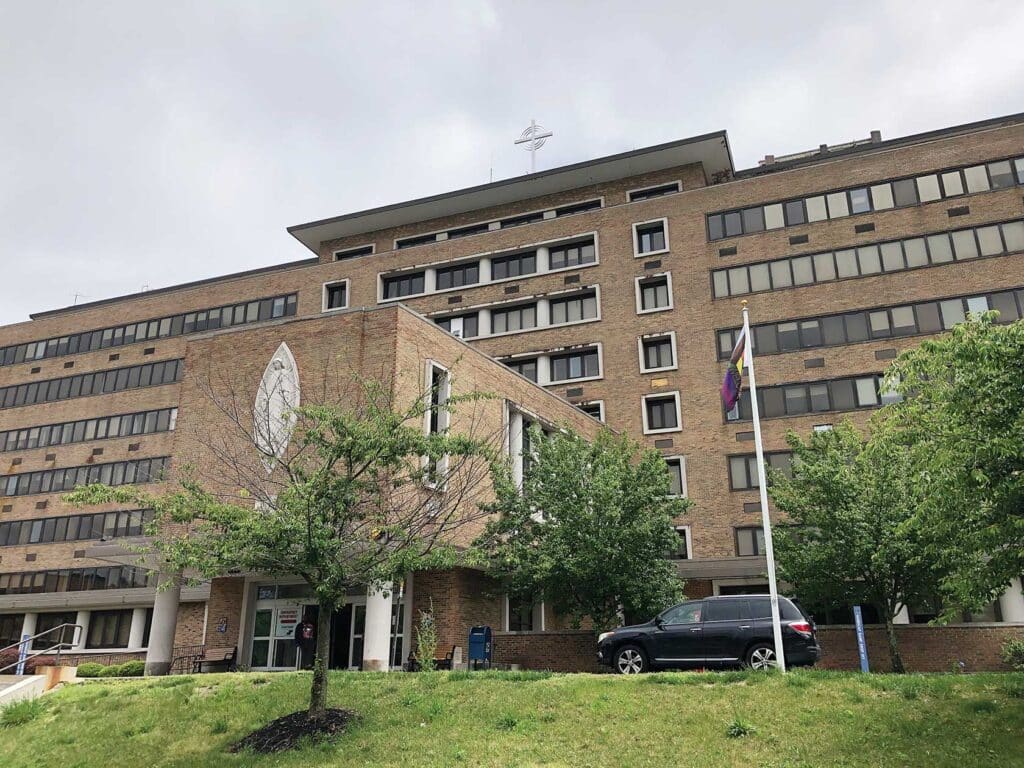Access gaps loom for Carney Hospital patients as closure date approaches
City efforts aim to bring increased health resources to the surrounding area

Even as officials look to shore up gaps in health care that will be left by the closure of Carney Hospital, local advocates said they worry efforts will still leave residents’ care lacking.
As the hospital plans to close its doors at the end of the week, alongside Nashoba Valley Medical Center in Ayer, medical leaders in the area said the gap will hit hardest for people already experiencing health care disparities — groups like minorities, immigrants and those facing language barriers.
“Those people are the voiceless,” said Dr. Jean Bonnet, an internal medicine doctor at Hyde Park Health Associates. “They need protection.”
The closure is coming on an expedited timeline that has raised flags for local advocates. In a federal Dallas-based bankruptcy court, Steward Health Care, which owns the hospital, announced at the end of July plans to close Carney Hospital Aug. 31, leaving only 36 days for a process that, under state regulations, is supposed to take 120 days.
In an Aug. 19 response to Steward’s closure plan, following a pair of public hearings, the state’s Department of Public Health identified Carney Hospital as an “essential service” but said that it does not have the power to mandate that the hospital remain open.
Separately, six other Steward Health Care campuses are awaiting sales to other local hospital operators in deals announced by Gov. Maura Healey Aug. 16. Those deals have been hampered by complaints and interference from the landlords who own the land on which the hospitals stand.
Locally, the city of Boston is looking to shore up gaps in access to care, said Dr. Bisola Ojikutu, executive director of the Boston Public Health Commission. That has included spinning up a local incident command team to identify where resources exist and where they don’t, with a focus on trying to keep any disparities that exist from getting worse.
“Our mission at the Boston Public Health Commission is to [further] health equity,” Ojikutu said. “We certainly don’t want this closure to further inequity.”
Partnerships can help
The commission’s response is, in no small part, focused on identifying what partnerships can be leveraged to make sure community members have some measure of continuity of care. Some gaps will be harder to fill than others, especially in services Carney offers that no other local institutions are currently equipped to provide.
For example, support from Dana-Farber Cancer Institute is one avenue for continued access to mammography for local residents.
Magnolia Contreras, vice president of community health at Dana-Farber, said, “Our work is to ensure continuity of care and access to care. … One of the negative outcomes with cancer is delaying care. We want to make sure that everyone has immediate access and gets connected to where they can have that mammography.”
Long-term questions of capacity remain — something Contreras said Dana-Farber will have to consider as they offer services in response to the closure — but in the short-term, she said, they’re ready to help as many people as possible.
In the case of those mammography services, Contreras said that access can be brought to the community by a mobile health van Dana-Farber operates — through which they can offer mammograms remotely from outside community health centers — or at an outpost Dana-Farber runs at Whittier Street Health Center in Roxbury.
She said she hopes that offering services right in the community should make the transition relatively smooth for patients.
“If the patient is looking to reschedule an appointment individually, they can just call our office and one of our mammography coordinators will ask them all these questions,” Contreras said. “We are ready to serve these patients.”
Other services are harder to bring into the community, like emergency services to rival the approximately 30,000 emergency department visits the hospital received in 2022.
A hospital nearby in Milton run by Beth Israel Deaconess also offers an emergency department, but Bill Walczak, a local health advocate who founded Codman Square Health Center and briefly served as president of Carney Hospital, said he worries that that hospital — the only one within a two-mile radius — it isn’t prepared to take on the thousands of patients who have relied on Carney for care.
According to data from the state’s Center for Health Information and Analysis, both Carney Hospital and Beth Israel Deaconess Hospital-Milton saw just over 30,000 emergency department visits in fiscal year 2022.
Boston Emergency Medical Services, which is run through the Public Health Commission, is working on steps to mitigate the impact that Carney’s emergency department closure could have. According to a spokesperson, Boston EMS is planning to add an additional ambulance, staffed 24/7, to increase coverage in Dorchester in the near future.
“With the closure of Carney Hospital, Boston EMS’s priority is to ensure all patients continue to receive the pre-hospital care that they need, regardless of where in the city services are required,” said Caitlin McLaughlin, a Boston EMS spokesperson.
Currently, the ambulance dedicated to the neighborhood operates out of a station at Carney Hospital. As of Monday, Boston EMS said they had not received word from Steward Health Care about the future of the station, but have a contingency plan in place if necessary, and are confident they can make a pivot without disrupting coverage.
Longer travel times
a concern
Wait times at the hospitals patients will be taken to, and travel times to those hospitals, continue to be points of concern for community members.
At a public hearing held at Florian Hall in Dorchester on Aug. 13, staff and supporters of the hospital repeated worries that the extended travel times could result in worse health outcomes for patients in the community.
Boston EMS is aware of the concern. In a statement, McLaughlin said that without services at Carney Hospital, patients transported to other hospitals will face longer travel times and potentially longer waits at hospitals that may already be experiencing capacity issues. Despite that, McLaughlin said, Boston EMS is focused on providing the best care they can.
“With some of the most highly skilled EMTs and paramedics, we remain committed to clinical excellence and are prepared to adjust, adding resources, to continue to provide compassionate care and timely delivery of lifesaving care,” she said.
A transition and closure plan filed with the state suggested that a drive from Carney Hospital to Boston Medical Center takes about 30 minutes. To St. Elizabeth’s Hospital in Brighton, off-peak travel time was also estimated to be 30 minutes, though during peak travel times, that could rise to an hour.
“There are people whose lives have been saved at the Carney Hospital because it’s quickly accessible for Dorchester, Mattapan, Hyde Park, Quincy, Milton,” Walczak said. “Minutes make a big difference.”
As the crow flies, Milton Hospital is the only acute-care facility within a two-mile radius. The next nearest hospital, Brigham and Women’s Faulkner Hospital, is about 3.6 miles away. Boston Medical Center is almost four miles, while Longwood Medical Area and its many hospitals clock in at about 4.75 miles.
A scattering of other health centers stretches from nearby Mattapan Square up toward downtown Boston, but those centers often have limited services compared to a full hospital and are bracing for a barrage of new patients they say will stress an already overloaded system.
Ojikutu said the Public Health Commission is looking to partner with the health centers to provide support so they can expand capacity and provide increased service as a local option.
“This has been a really challenging situation. We’re working with our hospital and community health center partners to ensure that the patients who had been receiving care at Carney Hospital have access to care,” she said.
Connecting residents to those other locations for care is a priority for the city, Ojikutu said. The Public Health Commission is releasing a one-page document with guidance for community members, and she encouraged residents to contact the Mayor’s Health Line at 617-534-5050 if they have questions around how to transition care.
But despite city efforts, some services will be hard to replace, like Carney Hospital’s 70 psychiatric care beds, the absence of which will burden an already limited behavioral health care system.
“A big chunk of the behavioral health care system falls apart even worse than it is now, and it’s not in good shape whatsoever,” Walczak said.
Some community members doubt that any steps other than keeping Carney Hospital open can really mitigate the harm that they worry will come with the hospital’s closure.
Walczak said he worries that the closure puts strain on an already fragmented system.
“Fragmented care … exists across Massachusetts, but especially in areas that have numbers of immigrants and people that are, you know, not connected to the health care system in a way that would allow them to feel that they have medical homes,” he said.
As they look toward what that impact might be, advocates described a gap between the neighborhood and bustling downtown hospitals. Bonnet said that while Carney hasn’t been a place where someone is likely to go for open heart surgery or a big transplant, it plays an important role in delivering care around daily medical essentials like treating diabetes or hypertension.
“Carney is the bridge between the community and the big institutions,” Bonnet said. “If you break up the bridge, what happens to those people? They will be on an island, with no way to get to the mainland.”






